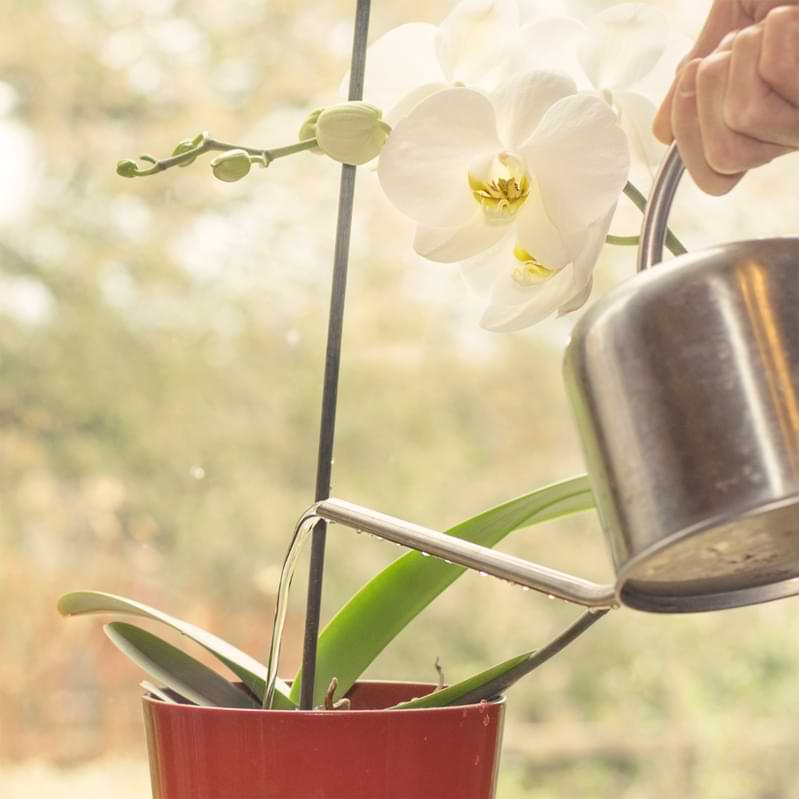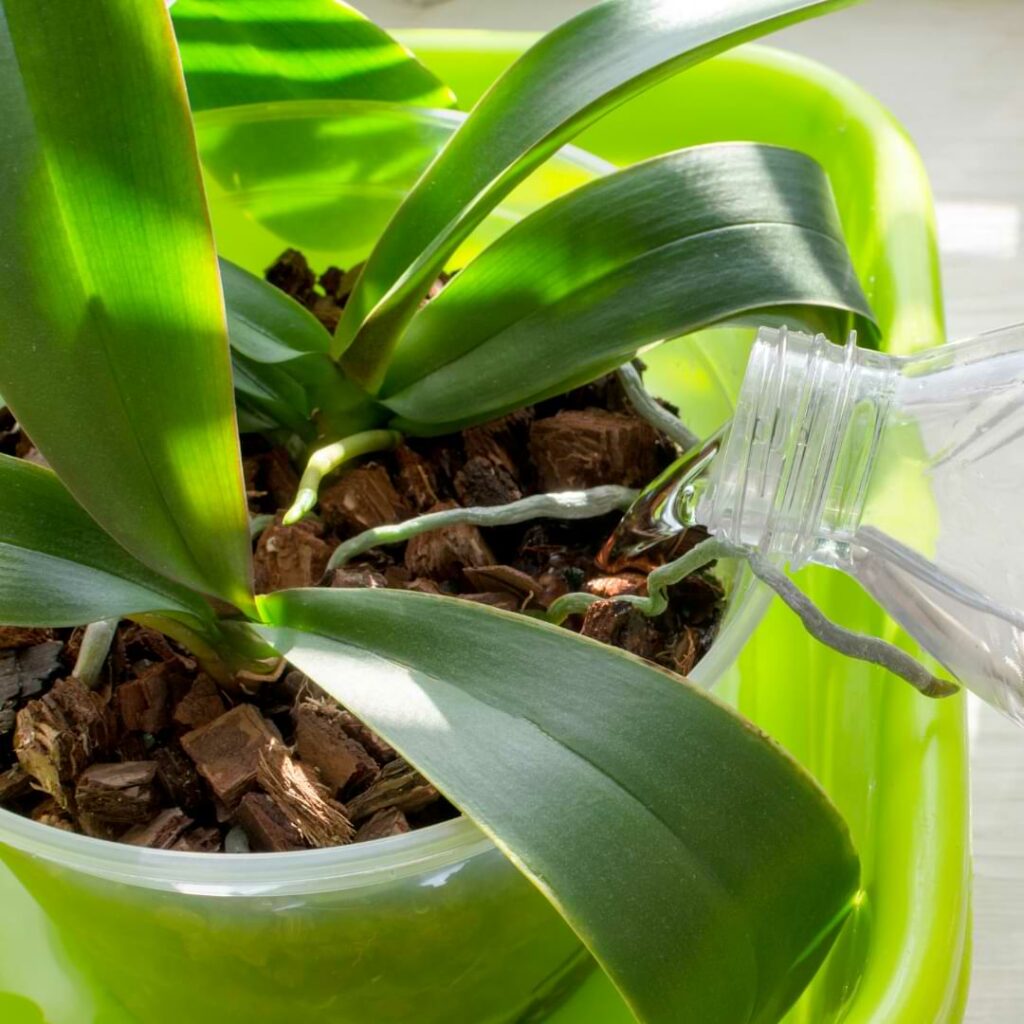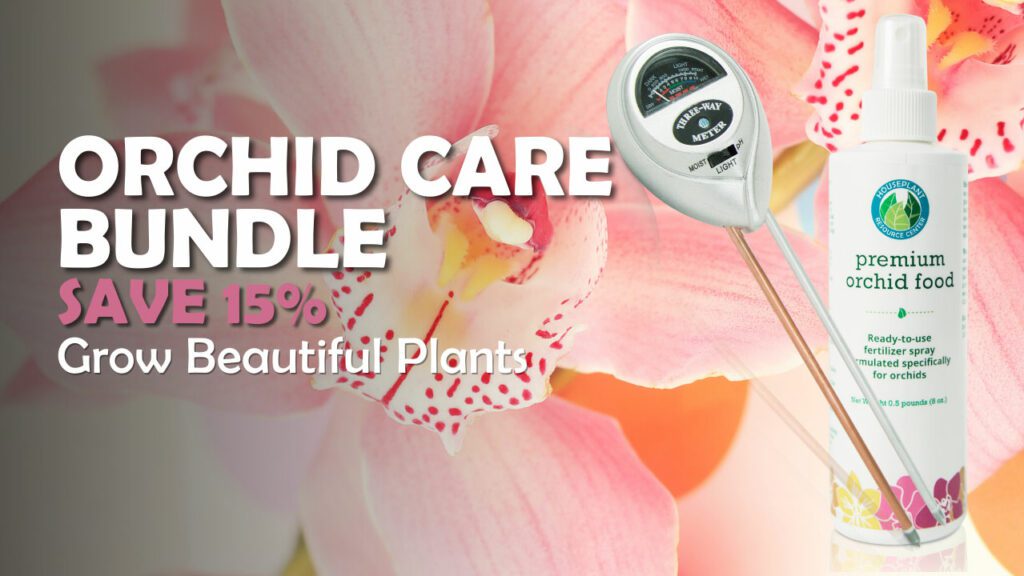A Simple Guide to Watering Orchids | How Often and How Much
Understanding how often to water orchids is vital to growing and maintaining these cosmopolitan flowers. Read on for our easy-to-follow watering guide and ensure the stunning aesthetics of your homegrown orchids always enhance your living space.
How Often To Water Orchids
Unlike other common houseplants, knowing how often to water orchids varies depending on various factors such as:
- orchid variety
- time of year
- stage of the growing cycle
- size of pot
- potting medium
- humidity levels
- temperature
Considering there are over 28,000 species of orchids, any combination of these variables can significantly impact how often to water orchids. However, there are a few general guidelines that can help you determine how often to water your orchids, no matter their specific needs:
- more water during warmer, drier months, as well as their active growing season
- orchids in smaller pots will need more frequent watering compared to those in larger pots
- orchids need significantly less water during their dormant phases in the fall and winter
- high humidity levels can reduce the need for frequent watering
- wood-based potting mediums may require more frequent watering than rock or gravel
These general guidelines should be applied to a once-weekly watering schedule, save for orchids in smaller pots, which require watering every 5 to 6 days rather than once every seven to ten days. When giving your orchid water, be sure to follow these tips to avoid over or under watering issues:
- topsoil isn’t a good indicator of water needs; check with your finger or a moisture meter
- 1/4 cup water is best for large potted orchids in summer months or active growth periods
- 2 tablespoons is ideal for dormant or fall/winter orchids
- check for drainage and never allow your orchid to sit in standing water
While your specific orchid may require a slightly different watering schedule, these guidelines will help you keep your orchids hydrated and healthy all year round. Be sure to regularly monitor the moisture levels of your orchid and adjust your watering as needed to ensure optimal growth and blooming.
How To Tell If Your Orchid Needs Watering
Knowing the best practices for how often to water orchids doesn’t always help you know when it’s time to use your watering can. Beyond the basic principles of keeping your orchid hydrated to its optimal levels, you should also consider these tell-tale signs that it needs watering.
Condensation
Orchids with excess condensation build-up on their pot are usually overwatered or lack the drainage needed to allow for healthy water levels for the plant. If you notice a lot of excess condensation, be sure to check your orchid’s roots and repot if necessary.
In some cases, orchid leaves will produce something called “happy sap,” which looks like condensed water on the underside of the leaves. This is a good sign that your plant is overhydrated and trying to eliminate excess moisture.
Weight of Pot
When your orchid is dry, the overall weight of the pot will be significantly lower. Lifting and getting a feel for the weight of your orchid’s pot after watering is highly recommended so you can better determine when it’s time to water again by comparing the two weights.
Substrate Dryness
Not all orchids are created equal; some prefer different potting mediums that suit their specific water needs. If the substrate you use feels dry throughout, this is an excellent indicator that it’s time to water your orchid.
Root Color
Orchids should have a healthy green color to their roots when sufficiently hydrated. If your orchid’s roots turn brown, black, or mushy, this is a sign of overwatering. Conversely, if the roots appear dry, grayish-white, hollow, or flat, it’s time to give your orchid some water.
Leaf Appearance
A green, shiny, firm look to orchid leaves indicates optimal hydration and health. Overwatered leaves look limp or leathery and sometimes turn a yellowish color. In addition, if new leaf growth appears pleated, it may be a sign you need to cut back on watering. However, if orchid leaves look wrinkled or shriveled, this is a sign of under-watering.
Bud Growth
A condition called bud blast is a key indicator that your orchids aren’t getting enough water. This is when orchid buds wither and fall off before they have a chance to bloom. If you notice this happening, it’s time to increase your watering frequency, as bud blast can be fatal to the growth of your orchids. Additionally, you may notice less frequent (or none at all) bud growth.
Stem Appearance
Stunted stem growth is a sign of underwatering, while yellowish coloration can be a sign of overwatering. Typically, the leaves and buds will be affected long before the stem, but if you notice these signs, you may need to adjust your watering drastically to avoid plant death.

How Often To Water Orchids Depending on Potting Medium
Watering Orchids in Wood Chip or Bark
Wood chips and bark from certain types of trees (such as fir) work great for orchid potting. Because these mediums break down faster than others, they may require more frequent watering to keep your orchids healthy. You can use the same general watering guidelines mentioned above, but be sure to check for dryness more frequently.
Watering Orchids in Moss
Sphagnum moss is a popular potting medium for orchids because it retains moisture well and can break down slowly. However, this also means your orchid may not need as frequent watering compared to other mediums. Check the substrate with your finger or moisture meter every few days to determine when it’s time to water.
Watering Orchids in Perlite, Gravel, or Moss
These potting mediums are known for their excellent drainage properties, meaning your orchid may require less frequent watering. However, it’s still important to regularly check the substrate’s moisture levels and adjust your watering schedule accordingly.
Pro Tip: If overwatering has been an issue in your orchid care, consider using smart gravel specially designed to absorb and release moisture at optimal levels.
Watering Mounted Orchids
Mounted orchids require a slightly different approach to watering, as they are not potted. Instead, they grow mounted to cork, driftwood, or coconut husk fiber. Because of this unique growing style, the roots are exposed, and there is no substrate to hold moisture.
Mounted orchids should be watered every 2-3 days by placing them under running water until thoroughly wet and then allowed to dry completely before watering again. However, like all other orchid species, you may be able to decrease watering frequency in the cooler months or depending on the humidity and temperature of your growing area.
Watering Orchid Arrangements
Handmade orchid arrangements can contain a variety of potting mediums and orchid species, making it difficult to determine an exact watering frequency. However, a general rule is to water once a week with 1/4 cup for every 4-inch pot size. Be sure to check the moisture levels of each individual plant in the arrangement and adjust your watering accordingly.
Misting Orchids
Misting can provide necessary humidity in dry climates or seasons and help clean the leaves of dust and debris. Additionally, it can be a great way to keep plants hydrated during dormant cycles when reduced watering needs can be complex to determine. Be sure to maintain similar water quality and temperature between misting and watering to avoid shock or stress on your orchids.
Tips For Watering Orchids
Time of Day
Watering orchids early in the morning is generally considered best, allowing excess water to evaporate throughout the day. This helps to prevent stagnant water from accumulating and causing root rot.
Type of Water
Ideally, you want to use rainwater for your orchid plants. Rainwater is chemical-free and has a balanced pH level, which is perfect for orchids. If you don’t have access to rainwater, you can use tap water, but only if it is free from chlorine and fluoride. If the quality of your tap water is an issue, filtered water will be the best alternative.
There is a great debate about whether distilled water should be used for orchids. Some say it’s too pure and lacks essential minerals, while others swear by its use. If you do choose to use distilled water, it’s wise to add an orchid plant food or multivitamin in small doses to help replace the essential minerals that may be lacking.
Water Temperature
Just like humans, orchids can react poorly to sudden temperature changes. So, only use water that matches the ambient temperature in the space you keep an orchid. An exception to this is using ice cubes to water Phalaenopsis orchids. The plants will take up the cool water as it melts, but be sure not to use too many cubes at one time and avoid contact between the ice and plant leaves or roots.
Bottom or Top Watering Orchids
Bottom watering can be a great way to keep your orchids hydrated without risking stagnant water accumulation on the surface of the potting medium. Be sure to only use this method for containers with drainage holes at the bottom, and do not leave your orchid sitting in water for extended periods.
To bottom water, fill a tray with water and place the orchid pot inside for 10 to 15 minutes until the top of the potting medium feels moist. When you pull it out, let the excess water drain before placing it back in its usual location.
If watering from the top, be sure to water at the base of the plant and avoid getting water on the leaves or flowers. This can help prevent fungal diseases and ensure your orchid’s foliage stays clean and healthy.
Orchid Watering FAQ
1. How often should I water an orchid in bloom?
Depending on the potting medium and growing conditions, at least once a week and possibly twice a week. Check the moisture levels of the medium regularly and adjust watering as needed.
2. How often should I water an orchid in winter?
Winter watering schedules should be every 7 to 10 days, depending on the potting medium and humidity levels.
3. How many ice cubes should I water my orchid with?
It is generally recommended to use 3-4 ice cubes per week for Phalaenopsis orchids. However, this can vary depending on your orchid plant’s size and specific species.
Keep Your Orchid Happy, Healthy, and Hydrated
When it comes to answering the questions about how often to water orchids, the answer isn’t always straightforward. But, by understanding the different potting mediums, unique watering needs for depending on the planting medium, and tips for misting and bottom/top watering, you can ensure your orchids get just the right amount of hydration they need to thrive for years to come.
Have you got more questions about orchid care? Subscribe to our newsletter and join our Facebook community for comprehensive tips and support from fellow orchid enthusiasts!



